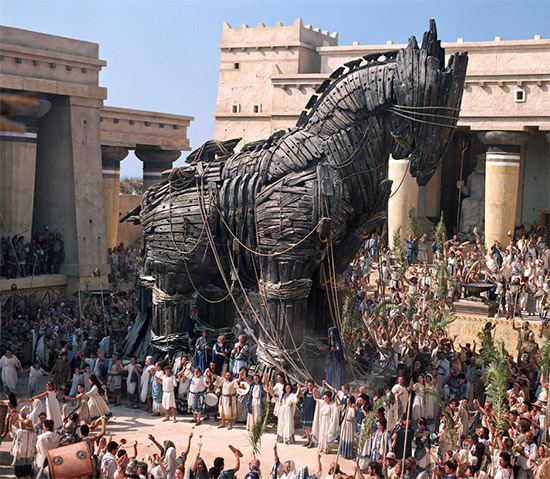(12th or 13th Century B. C. E.)
Legendary Bronze Age conflict between Mycenaean Greeks and Troy. Despite the problems inherent in any attempt to employ the Homeric epics in a historical reconstruction of the Trojan War, the latest archaeological evidence from and around the site of Troy has led many scholars to reappraise the Homeric tradition of a major expedition against the city.
For the Greeks, the Homeric epics were history, and they located Troy at a hill now called Hissarlik in northwestern Anatolia. Excavations of the site have revealed at least nine settlements dating from the early Bronze Age to late antiquity. With its recently discovered fortified lower town, Troy VIh/VIIa, destroyed about 1270 B. C. E., is the favored candidate for the “well-walled city with lofty towers” of Homer’s Iliad. Archaeology has revealed that it was not only in contact with the Near East but also with Mycenaean Greece, where a flourishing and warlike civilization existed. Near Eastern texts also suggest an involvement of the Mycenaeans in western Anatolia at about the right time. In particular, Hittite archives mention individual chieftains and their war bands crossing the Aegean Sea and raiding up and down the Anatolian coastline.
The unearthing of an extensive Bronze Age cemetery below the headland of Yassi Tepe and within a few meters of what was then a sheltered sandy beach suggests Mycenaean military activity within the vicinity of Troy. Comprising some 200 graves that included Mycenaean artifacts dating to about 1300 B. C. E., the cemetery, which the ancients always regarded as the tomb of Achilles, lies only 7 kilometers to the southwest of Troy. Because it does not relate to any permanent settlement in the area, it seems reasonable to infer that the cemetery was once associated with an anchorage for Mycenaean ships.
It did not need many warships full of armed raiders to threaten and sack a small city and enslave its people: six vessels, each manned by 50 warriors, sack Troy in a Hercules legend. In the Homeric epics, a leader’s greatest claim to glory was to be awarded the title “sacker of cities.” In the Iliad, a hero does not sack cities to increase his political power but does so in order to gain booty and women for himself and his followers. Indeed, the Linear B tablets that list captive women from the eastern Aegean provide vivid evidence for the predatory nature of the Mycenaeans in this region.
Guarding the mouth of the Dardanelles (Homer’s Hellespont), Bronze Age Troy’s strength and wealth lay primarily in its location. There is evidence for a marine bay that existed in what is now the Trojan plain, and it is clear that Troy was founded on a spur that stuck out into it. The bay provided a valuable harbor for any shipping entering the Dardanelles from the Aegean Sea and facing adverse currents and winds. More often than not, ships had to wait for favorable winds in Trojan waters, whereby the Trojans could exact levies and provide goods and services. Troy may have grown rich from tribute and long been a thorn in the side of people like the Mycenaeans. Its sack by a coalition of Mycenaean war bands has made an everlasting impression.
References and further reading: Easton, Donald. The Quest for Troy. London: Weidenfeld & Nicolson, 1997. Wood, Michael. In Search of the Trojan War. Berkeley: University of California Press, 1998.
